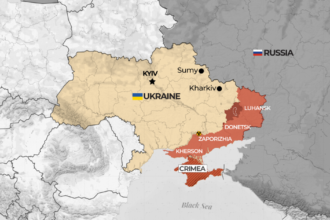In recent months, Russia has dramatically escalated its use of unmanned aerial vehicles (UAVs), launching relentless waves of drone attacks across Ukraine. This strategy, which blends psychological warfare with tactical destruction, is beginning to take a heavy toll not only on Ukraine’s infrastructure but also on the morale of its people and military.
As the war enters another grueling phase, the skies over Ukraine are increasingly filled with the ominous hum of Iranian-made Shahed drones and Russian-engineered UAVs. These drones are being used to target power stations, water supplies, civilian neighborhoods, and even frontline positions, often flying at low altitudes to avoid detection. The scale and frequency of the attacks are causing widespread fear, fatigue, and emotional exhaustion among Ukrainians, both in uniform and in civilian life.
A Weapon of Attrition and Terror
Military analysts describe Russia’s drone campaign as a calculated war of attrition. While not always effective in terms of raw destruction compared to missiles or artillery, the psychological impact of continuous drone bombardment is immense. Ukrainian citizens live in a state of near-constant alert. Air-raid sirens have become a daily routine in cities like Kyiv, Kharkiv, and Dnipro, while rural communities face sudden nighttime attacks that leave homes in ruins.
Drones are now a cheap but highly disruptive weapon in Russia’s arsenal. Costing significantly less than ballistic missiles, these UAVs can be produced quickly and deployed en masse. By launching dozens in coordinated swarms, Russia overwhelms Ukrainian air defense systems, forcing them to expend expensive interceptor missiles on low-cost targets.
Oleksandr, a soldier stationed near Bakhmut, told Ukrainian media that drones now play a central role in the conflict. “They never stop. Morning, noon, and night. The buzzing keeps you awake. You don’t know when or where the next one will strike.”
Civilian Life Under Siege
Beyond the battlefield, the constant drone threat is reshaping life for millions of Ukrainians. Schools, hospitals, and cultural centers have been struck. Power outages caused by targeted drone attacks on substations are common, leaving residents without electricity or heating during critical months.
Maria, a schoolteacher in Odesa, described how her students now learn in underground shelters. “The children draw pictures of drones with angry faces. It’s become a part of their lives, something no child should know,” she said.
The drone war has also disrupted humanitarian efforts. Aid convoys must now navigate not only dangerous roads but also the risk of aerial strikes. International organizations have reported delays and difficulties in delivering supplies, especially in eastern Ukraine where drone activity is most intense.
Strain on Ukrainian Defenses
While Ukraine’s air defenses have been largely effective in intercepting many drones, the strain on resources is growing. Western-supplied systems like NASAMS and IRIS-T have helped shield major cities, but rural areas remain vulnerable. Furthermore, intercepting drones is not a sustainable solution in the long term, as the cost disparity heavily favors Russia’s low-tech strategy.
Ukrainian military officials acknowledge the challenge. “We are adapting, but we need more electronic warfare systems and counter-drone technology,” said Colonel Yuriy Ihnat, a spokesperson for Ukraine’s Air Force. “This is not just a test of arms—it’s a test of will.”
Morale at a Crossroads
One of the most insidious impacts of the drone war is on Ukrainian morale. As the war drags on, fatigue is deepening. Repeated attacks on civilian infrastructure, coupled with the uncertainty of drone strikes, are wearing down the public’s resilience. Though determination remains strong, cracks are beginning to show.
Mental health professionals report rising cases of anxiety, depression, and PTSD. The Ukrainian government is trying to expand psychological support services, but the demand far outpaces supply.
Still, many Ukrainians remain defiant. “They may destroy our buildings,” said Kyiv resident Andriy, “but they won’t break our spirit.”
Conclusion
Russia’s intensifying drone war marks a grim evolution in the conflict—a strategy that inflicts maximum psychological damage while requiring minimal investment. It’s a war not just of weapons but of nerves, designed to slowly erode Ukraine’s will to fight. As the international community continues to support Ukraine with air defense systems and humanitarian aid, it’s becoming clear that the drone war must be met not only with technology but with resilience, innovation, and solidarity.










